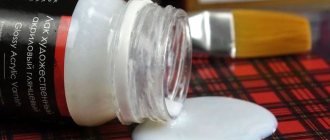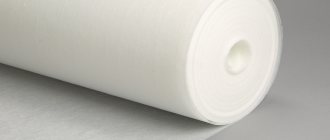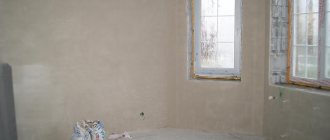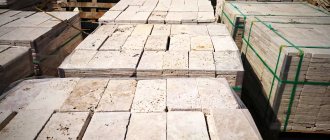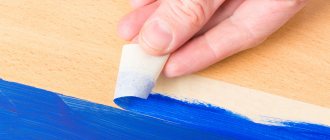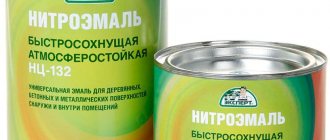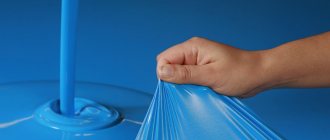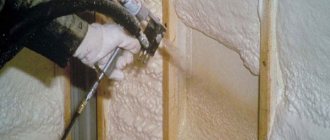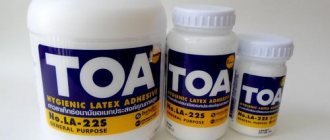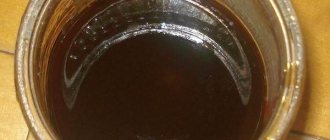Masking tape is a real salvation for construction and painting work. With its help, perfectly straight lines are created on all surfaces, it is resistant to chemicals and temperature changes, and can be removed from the treated areas carefully and without residue. Paper tape is used in many areas, is easy to use, and has a large number of varieties.
Specific features of masking tape
Crepe is used when painting; its relief structure delays the flow of paint and varnish materials, protecting nearby surfaces. Low adhesion allows the device to be removed without leaving dirty marks or damaging coatings.
With its help, they form clear boundaries of painted areas; it is a design tool that helps recreate intricate geometric fragments and patterns.
Not only residential areas are painted, but also car bodies; some tape types can withstand exterior conditions. Scotch tape is needed for:
- Creating a flat painting area, separating neighboring areas from paint.
- Clear restrictions when using different colors.
- Reproduction of both straight and curved lines.
Raw materials are used to create internal and external stencils and make markings.
Recommendations for use
Before gluing the tape, the surface must be degreased.
Using adhesive tape is simple, but you should follow some recommendations.
- Before gluing, the surfaces are cleaned of dirt, dried and degreased . The latter is done when working with complex surfaces, such as metal or stone.
- When gluing, the tape is not twisted or bent , unless it is a radius version.
- Remove fresh tape , smoothly detaching the strip from the surface. Sudden movements should not be made, otherwise the material may be damaged.
- If the tape is already dry , it is first soaked with warm or hot water. Damp crepe peels off easily.
In some cases, wetting with oil helps, since under its influence the glue loses adhesion.
Extraordinary application
They also use tape in a non-standard way, collecting broken glass, small scattered elements of needles, and beads. When drilling into the wall, hang a funnel or newspaper envelope under the hole with adhesive tape so that flying debris does not accumulate on the floor.
In addition, they successfully implement:
- Sawing so that the boards are without chips;
- Restoration of books;
- Making patterns;
- Securing garlands for the holiday;
- Cleaning fabric from pellets and animal hair;
- Measurements alone, fixing a long tape measure by one edge;
- Precise drilling of slippery glass or mirror.
Samples are used to seal wooden windows during cold seasons and provide sealing of pipes, joints, and refrigeration units. To avoid damage during installation, the door panels are pasted over, and the transported furniture is wrapped in bubble wrap, securing it with crepe.
Pieces of adhesive substance can even stop bleeding from a small wound, if there is no first aid kit nearby, and remove splinters.
Types of masking tape
The most popular in everyday life is the paper version, coated with natural or synthetic rubber glue. This tandem has:
- Good adhesion properties to both smooth and porous surfaces.
- Maintaining temperature readings within the range of -10 - +120.
- UV and moisture resistant.
- Durable, but edge tears are possible.
- Resistant to solvents.
- Easy to remove.
- Low mass.
- Versatility.
- Affordable price.
Instead of paper, aluminum foil, polyethylene, polypropylene, multi-colored fabric, and bitumen are used. Heat-resistant samples are required when painting cars; they are not afraid of high temperatures when drying, withstanding +150 degrees for an hour.
The aluminum option is an excellent sealant. Double-sided tapes have both sides adhesive, which allows you to hold objects together without nails or screws. They are made on the basis of propylene (PP) or fiberglass (PVC), and come in mirror subtypes.
Moisture-resistant models are designed for outdoor work. The bitumen variation promises reliable insulation; it will be required when connecting elements and installing heated floors.
Fabric modifications are available in different color palettes. The lapel material is divided into a wide adhesive strip and a narrow plastic part, which goes under the tab behind the sealing elastic band, covered with an adhesive part on top.
Elastic radius variation makes it possible to create curves and logos. Some specimens combine all the positive qualities, but this increases their price tag. The purpose of a protective polyethylene or paper sheet equipped with crepe is to protect bulk coatings from stains.
Dyeing technology
Painting tape will be useful when creating an interesting decor using at least two colors. The sequence of painting and drawing on the walls may differ depending on the idea, but most often it is determined by the following standard steps:
- Choice of shades of the color palette.
- Creating a sketch of the future pattern.
- Drawing chalk borders on the wall to attach the tape.
- Applying masking tape.
- Painting the surface as planned.
- Dry the surface and remove the masking tape.
In addition, the tape can act as a stencil to create a pattern on a plain wall. To achieve stronger adhesion, it is recommended to smooth the surface of the masking tape with a plastic card.
Colored masking tape
Gamma has a varied spectrum. Yellow and white rolls are used to cover walls and ceilings before painting. Color marks cargo and goods and hides defects.
Brown color is used to glue cardboard boxes together. Blue moisture-resistant tape with latex is used for facade decoration on plastic, metal, double-glazed windows, and fences.
Green tape resistant to thermal shocks. The pink and purple type is used when processing delicate plaster, wood, and wallpaper.
GOST and marking
GOST 18251-87. This standard applies to wet-activated adhesive tapes used for gluing veneer, plywood, gluing cardboard boxes, gluing plexiglass and gluing telegrams.
The marking of the crepe tape is indicated in GOST.
The following grades of base paper should be used to make adhesive tape.
| Brand of adhesive tape | Base paper grade according to GOST 10459-87 |
| A | A |
| A | A |
| B | B |
| IN | IN |
| IN | IN |
| IN | IN |
| D | B according to GOST 19625-83 |
It is allowed to use other types of paper as base paper for the production of tape, provided that the quality indicators of the tape meet the requirements of this standard.
The tape must be produced in reels. The bobbin sizes are indicated.
| Tape brand | Bobbin width, mm | Prev. off, % | Reel internal diameter, mm | Prev. off, % | Reel outer diameter, mm | Prev. off, % |
| A, A | 12, 15, 18, 20, 25 | ±8 | 50, 65, 70 | ±5 | 320, 250, 350 | ±4 |
| B | 60, 80 140 | ±2 ±1 | 50, 65 | ±5 | 350 | ±4 |
| B, B | 50, 65, 70, 75, 80, 100 | ±3 | 70, 75 | ±5 | 250, 320 | ±4 |
| IN | 25, 40, 50, 60 70, 75, 100 125, 150, 180, 200 | ±5 ±6 ±5 | 50, 65, 70 | ±5 | 250, 320, 350 320 | ±4 ±4 |
| D | 10 | ±1 | 50 | ±4 | 190 | ±3 |
The packaging of adhesive tape usually indicates: winding length, tape width, materials, scope of application, maximum permissible gluing times and some other characteristics.
Manufacturers of masking tape
The standard products are produced by the German company, and the American company offers a professional line.
- The South Korean brand “FOLSEN” and the Italian “SPINO” have proven themselves well.
- The brands “TOPEX”, “FIT”, “AVIORA” are suitable for home repairs.
- From domestic ones, “Zubr”, “Staler”, etc.
Cleaning up traces
Without a trace of peeling off is an important plus, but if for some reason residual stains appear, they are removed:
- Soap solution;
- From glass with alcohol or lotion;
- On MDF with gasoline;
- From wood or plastic by heating with a hairdryer;
- From ceramics and tiles with acetone, acetic acid, glass cleaner;
- An ordinary school eraser.
Soda paste with water also helps, wipe the area with it and rinse off with liquid.
Removing crepe
In order for the masking tape to be easily and without problems removed from the surface, the crepe should not be glued for a long time. After being glued for a long time, you will need to make efforts and additional means:
- To remove it from plastic, you need to treat the material with oil, and after one or two hours remove the tape, then wash the surface with detergent. Traces of glue can be erased with a regular eraser. And if the glue is very dry, you first need to heat it with a hairdryer, after which it is much easier to remove;
- from polished furniture, the adhesive layer is removed with an eraser, vegetable oil or a drill fitted with a special attachment;
- Acetic acid, acetone, and glass cleaner are used to clean tiles, glass and ceramics.
So, masking tape is an indispensable, universal assistant for various tasks. This tape is very useful during painting and decorating projects and is often used by professionals in various fields.
Criterias of choice
When choosing raw materials, they rely on width and length. The standard winding is 5 cm and 50 m. Wide elements are used to insulate windows, and narrow elements are used to decorate curved borders on elongated areas and to seal joints.
The tensile strength depends on the thickness. In everyday life, the optimal figure is 125 microns and above. Brand offers are a priority for professionals.
It is not recommended to exceed the application time, otherwise it will not be easy to remove the remaining glue.
Coatings are carefully prepared by puttingty and priming them.
- Follow the recommendations on the manufacturer's labeling. Freshly painted walls are dried for a day, or at worst, at least a few hours, and treated with tape for delicate surfaces, otherwise the result will be disappointing.
- It is better not to buy cheap products that can peel off when soaked in paint; they do not fit tightly and leave unpleasant smudges.
With the help of a universal assistant, many repair tasks are solved; it is indispensable for painting operations. Numerous offers on the modern market allow users to purchase the required masking tape that satisfies their needs and expectations.
Technical specifications
Compared to other materials for construction work, painting has the following advantages:
- Huge variety of sizes (large, compact, width and thickness);
- Relatively light weight;
- Low price;
- Great feature of masking tape.
- Decent thickness of tape.
The parameters that masking tape has set it apart from all other materials:
- Very resistant to tearing on any surface;
- Withstands a wide temperature range from -10 to +120 degrees;
- Resistant to a variety of adverse natural phenomena;
- Compatible with other types of paints, elements and details;
- Quickly removed from any material and washed without problems;
- Can be used to create templates necessary for making inscriptions or markings;
- Quite elastic.
On video: testing masking tape and masking tape.
